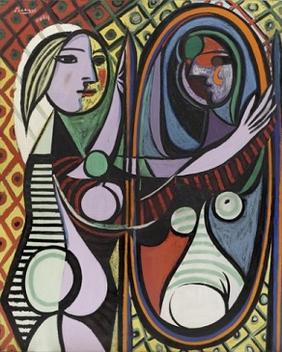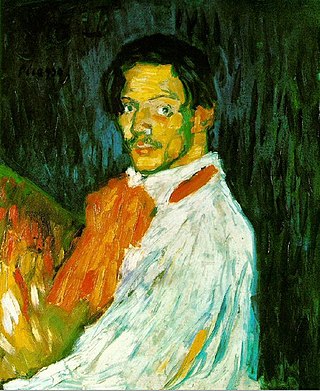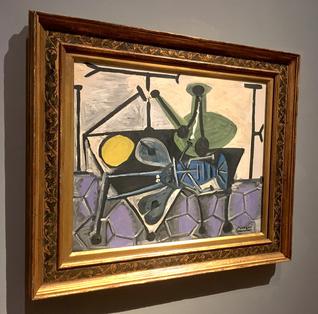Related Research Articles

Georges Braque was a major 20th-century French painter, collagist, draughtsman, printmaker and sculptor. His most notable contributions were in his alliance with Fauvism from 1905, and the role he played in the development of Cubism. Braque's work between 1908 and 1912 is closely associated with that of his colleague Pablo Picasso. Their respective Cubist works were indistinguishable for many years, yet the quiet nature of Braque was partially eclipsed by the fame and notoriety of Picasso.

Pablo Ruiz Picasso was a Spanish painter, sculptor, printmaker, ceramicist, and theatre designer who spent most of his adult life in France. One of the most influential artists of the 20th century, he is known for co-founding the Cubist movement, the invention of constructed sculpture, the co-invention of collage, and for the wide variety of styles that he helped develop and explore. Among his most famous works are the proto-Cubist Les Demoiselles d'Avignon (1907) and the anti-war painting Guernica (1937), a dramatic portrayal of the bombing of Guernica by German and Italian air forces during the Spanish Civil War.

The Rose Period comprises the works produced by Spanish painter Pablo Picasso between 1904 and 1906. It began when Picasso settled in Montmartre at the Bateau-Lavoir among bohemian poets and writers. Following his Blue Period – which depicted themes of poverty, loneliness, and despair in somber, blue tones – Picasso's Rose Period represents more pleasant themes of clowns, harlequins and carnival performers, depicted in cheerful vivid hues of red, orange, pink and earth tones.
The Blue Period comprises the works produced by Spanish painter Pablo Picasso between 1901 and 1904. During this time, Picasso painted essentially monochromatic paintings in shades of blue and blue-green, only occasionally warmed by other colors. These sombre works, inspired by Spain and painted in Barcelona and Paris, are now some of his most popular works, although he had difficulty selling them at the time.

Picasso's African Period, which lasted from 1906 to 1909, was the period when Pablo Picasso painted in a style which was strongly influenced by African sculpture, particularly traditional African masks and art of ancient Egypt, in addition to non-African influences including Iberian sculpture, and the art of Paul Cézanne and El Greco. This proto-Cubist period following Picasso's Blue Period and Rose Period has also been called the Negro Period, or Black Period. Picasso collected and drew inspiration from African art during this period, but also for many years after it.

Julio González i Pellicer, born in Barcelona, was a Spanish sculptor and painter who developed the expressive use of iron as a medium for modern sculpture. He was from a lineage of metalsmith workers and artists. His grandfather was a goldsmith worker and his father, Concordio González, a metalsmith worker who taught him the techniques of metalsmith in his childhood years. His mother, Pilar Pellicer Fenés, came from a long line of artists.

Aldo Crommelynck was a Belgian master printmaker who made intaglio prints in collaboration with many important European and American artists of the 20th century. At the time of his death, The Guardian termed Crommelynck the 'pre-eminent' and 'the most celebrated printmaker of the second half of the 20th century.'
Galerie Louise Leiris was a fine art gallery in Paris established by Daniel-Henry Kahnweiler in 1920.
Las Meninas is a series of 58 paintings that Pablo Picasso painted in 1957 by performing a comprehensive analysis, reinterpreting and recreating several times Las Meninas by Diego Velazquez. The suite is fully preserved at the Museu Picasso in Barcelona and is the only complete series of the artist that remains together. This is a very extensive survey work, which consists of 45 performances of the original picture, 9 scenes of a dove, 3 landscapes and a portrait of Jacqueline.

The Vollard Suite is a set of 100 etchings in the neoclassical style by the Spanish artist Pablo Picasso, produced from 1930-1937. Named after the art dealer who commissioned them, Ambroise Vollard (1866-1939), the suite is in a number of museums, and individual etchings from the suite are collectible. More than 300 sets were created, but many were broken up and the prints sold separately.

The Blue Guitar is a suite of twenty etchings with aquatint by David Hockney, drawn in 1976–77 and published in 1977 in London and New York by Petersburg Press.

Girl before a Mirror(French: Jeune fille devant un miroir) is an oil on canvas painting by Pablo Picasso, which he created in 1932. The painting is a portrait of Picasso's mistress and muse, Marie-Thérèse Walter, who is depicted standing in front of a mirror looking at her reflection. It is housed in the collection of the Museum of Modern Art in New York City.

Diana Widmaier Picasso is a French art historian specialized in modern art, living in Paris.

Yo, Picasso, is an oil-on-canvas painting by Pablo Picasso, which he painted in 1901. It is a self-portrait of the artist that depicts him in his youth, aged 19. The painting was created at the beginning of Picasso's Blue Period. On 9 May 1989, the painting sold at Sotheby's, achieving a price of $47.85 million, making it one of the most expensive paintings sold up to that date.

The 347 Series or 347 Suite is a series of etchings by the Spanish artist Pablo Picasso executed between March 16 and October 8 1968. The work was Picasso's largest in terms of the number of individual prints in the series; and his penultimate large etching series before the 156 Series of 1969-1972. It was dedicated to his friend Jamie Sabartes. No name was given by Picasso to the series. The 347 series was first displayed at the Art Institute of Chicago and Paris's Galerie Louise Leris in 1970.

Nature morte au poron is a 1948 oil-on-canvas painting by Pablo Picasso. It is a still-life painting in a cubist style. Picasso painted three versions of the work on 26 December 1948; one is in the collection of the Welsh National Museum of Art, Cardiff, Wales. The painting measures 50.3 × 61 cm.
Pierre Roy was a French surrealist painter. He is known for his realistically painted compositions of ordinary objects in unexpected arrangements.

Famille d'acrobates avec singe is a 1905 painting by Pablo Picasso. It depicts a family of travelling circus performers during an intimate moment. The work was produced on cardboard using mixed media: gouache, watercolour, pastel and Indian ink. It is held by the Gothenburg Museum of Art in Gothenburg, Sweden. The work was painted at a key phase in Picasso's life, as he made the transition from an impoverished bohemian at the start of 1905 to a successful artist by the end of 1906.
References
- ↑ "'Etching: 11, 28 February 1970 3, 16, 30 March 1970 (L.13)', Pablo Picasso". Tate . Retrieved 2012-05-20.
- ↑ "'At Work', Pablo Picasso". Museum of Modern Art . Retrieved 2012-05-20.
- ↑ "'Galerie Louise Leiris, Picasso', Pablo Picasso". Museum of Modern Art. Retrieved 2012-05-20.
- ↑ "Monument, Pablo Picasso". Museum of Modern Art. Retrieved 2012-05-20.
- ↑ "Pirosmanachvili à son chevalet from Pirosmanachvili 1914, Pablo Picasso". Museum of Modern Art. Retrieved 2012-05-20.
- ↑ "eMuseumPlus - Quatre personatges o La conversa". Museu Picasso . Retrieved 2012-05-20.